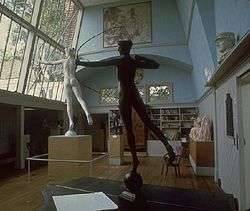Cornish Art Colony

The Cornish Art Colony (or Cornish Artists’ Colony, or Cornish Colony) was a popular art colony centered in Cornish, New Hampshire from about 1895 through the years of World War I. Attracted by the natural beauty of the area, about 100 artists, sculptors, writers, designers, and politicians lived there either full-time or during the summer months. With views across the Connecticut River Valley to Mount Ascutney in Vermont, the bucolic scenery purported to resemble that of an Italian landscape.
The central figure of the Cornish Colony was Augustus Saint-Gaudens. Beginning around 1885, Augustus attracted a summer colony of artists that grew into a single extended social network. Some were related, some were friends, some were promising students from the Art Students League of New York that Saint-Gaudens had co-founded, and some were Saint-Gaudens' assistants who developed significant careers of their own.
After his death in 1907 it slowly dissipated. His house and gardens are now preserved as Saint-Gaudens National Historic Site.
Though the colony's name referred to its social center in the village of Cornish, geographically it was spread out over the villages of Windsor, Vermont and Plainfield, New Hampshire as well. Windsor was the mailing address for the entire area and the arrival point of most of the colonists, who usually came from New York City by train.[1]
People associated with the Cornish Colony

- Adeline Pond Adams, poet and art historian
- Herbert Adams, sculptor
- Ethel Barrymore, actress
- George de Forest Brush, painter
- Winston Churchill, American novelist
- Kenyon Cox, painter and muralist
- Thomas Dewing, painter
- Marie Dressler, actress
- Isadora Duncan, dancer
- Barry Faulkner, muralist and mosaicist
- Daniel Chester French, sculptor
- Henry Brown Fuller, painter
- Learned Hand, judge
- Percy MacKaye, dramatist
- Paul Manship, sculptor
- Rose Standish Nichols, garden designer, writer, and activist
- Maxfield Parrish, painter and muralist
- Stephen Parrish, painter and etcher
- Maxwell Perkins, editor
- Charles A. Platt, architect and garden designer
- Edith Prellwitz, painter
- Henry Prellwitz, painter
- Frederic Remington, painter, sculptor and author
- Augustus Saint-Gaudens, sculptor
- Louis St. Gaudens, sculptor and Augustus Saint-Gaudens' brother
- Everett Shinn, painter and illustrator
- Florence Scovel Shinn, illustrator and writer
- Ellen Biddle Shipman, landscape architect
- Bessie Potter Vonnoh, sculptor
- Robert Vonnoh, painter
- Woodrow Wilson, American president
- William Zorach, sculptor
References
External links
- AskART: Cornish Colony
- Cornish Colony Museum
- Augustus Saint-Gaudens, Master Sculptor, exhibition catalog fully online as PDF from The Metropolitan Museum of Art